#Aquia Formation fossil
Explore tagged Tumblr posts
Photo

Fossil Ray Tooth Plate Myliobatis sp Aquia Formation Palaeocene Maryland USA Genuine
Fossil Ray – Myliobatis sp. (Eagle Ray Tooth Plate)
Geological Period: Late Palaeocene (Thanetian Stage)
Age: Approximately 59 to 56 million years ago
Formation: Aquia Formation
Locality: Wades Bay, Charles County, Maryland, USA
This listing features a genuine tooth plate from Myliobatis sp., a genus of eagle ray that once inhabited the warm, shallow seas of what is now the Atlantic Coastal Plain of North America. This fossil comes from the Aquia Formation, a well-known Late Palaeocene marine deposit exposed along the Potomac River and its tributaries.
The Myliobatis tooth plate is characterised by its flat, pavement-like structure, composed of interlocking teeth adapted for crushing hard-shelled prey such as mollusks and crustaceans. These rays were part of the elasmobranch lineage, related to modern rays and sharks, and played an important ecological role in Palaeocene marine ecosystems.
The Aquia Formation, dating to the Thanetian stage of the Palaeocene, consists of glauconitic sands and silts deposited in a shallow marine environment. Fossils from this formation include a rich variety of shark teeth, ray dentition, bony fish, and marine reptiles.
Actual Specimen Pictured: The item you see is the exact fossil you will receive.
Scale: 1cm cube included in the image for accurate sizing. Please refer to the photo.
Condition: Naturally preserved and stable; some wear consistent with aquatic fossilisation processes.
Excellent for:
Fossil collectors and marine palaeontology enthusiasts
Educational and teaching collections
Natural history exhibits
Thoughtful gifts for lovers of ancient sea life
All of our Fossils are 100% Genuine Specimens & come with a Certificate of Authenticity.
We carefully select each specimen based on authenticity, scientific interest, and visual appeal.
#fossil ray tooth#Myliobatis fossil#Aquia Formation fossil#Palaeocene ray#Wades Bay fossil#Maryland fossil#Thanetian marine fossil#stingray fossil#fossil fish plate#prehistoric ray tooth#fossil elasmobranch#real ray fossil#ray dentition fossil#Myliobatidae fossil#USA marine fossil
0 notes
Text




Fossil shark teeth! 🦈
Worth wading in the cold river for.
4 notes
·
View notes
Text
Presbyornis

By José Carlos Cortés on @quetzalcuetzpalin-art
PLEASE SUPPORT US ON PATREON. EACH and EVERY DONATION helps to keep this blog running! Any amount, even ONE DOLLAR is APPRECIATED! IF YOU ENJOY THIS CONTENT, please CONSIDER DONATING!
Name: Presbyornis
Status: Extinct
First Described: 1926
Described By: Wetmore
Classification: Dinosauria, Theropoda, Neotheropoda, Averostra, Tetanurae, Orionides, Avetheropoda, Coelurosauria, Tyrannoraptora, Maniraptoriformes, Maniraptora, Pennaraptora, Paraves, Eumaniraptora, Averaptora, Avialae, Euavialae, Avebrevicauda, Pygostylia, Ornithothoraces, Euornithes, Ornithuromorpha, Ornithurae, Neornithes, Neognathae, Galloanserae, Anseriformes, Anatoidea, Presbyornithidae
Referred Species: P. isoni, P. mongoliensis, P. pervetus, P. recurvirostrus
Here it is - the titular Flamingo Duck! Presbyornis was an extremely common and vital part of early Paleogene communities, and given it has relatives from the late Cretaceous, forms a bridge across to demonstrate a major group of dinosaurs that survived the end-Cretaceous extinction. It is known from both Asia and North America, a fairly wide distribution. Specifically it’s been found in the Naran Bulak Formation of Mongolia; the Margaret Formation of Nunavut, Canada; the Aquia Formation of Maryland; the Colton Formation and Green River Formations of Utah; and the Bridger Formation and Wasatch Formation of Wyoming. Given these locations and the placement of Presbyornis within them, it seems this bird lived from 62 million years ago to 48.6 million years ago - from the Danian of the Paleocene to the Ypresian of the Eocene. This indicates this bird was present immediately after the end-Cretaceous extinction, and persisted through the early Eocene.

By Henry Thomas on @raptorcivilization
Presbyornis was very distinct in its appearance - a duck-like skull, long and slender neck, and extremely long legs, with shallow muscle attachment sites on the wings and less fused bones of the legs. Some species were about goose sized, while others were larger, about the size of swans. They also have shorter bones around the eye sockets, thinner backs of the head, and larger holes on the sides of the skull than your usual bird. This gave Presbyornis and its relatives a slightly more ancestral body plan than modern ducks, though it wouldn’t have been extremely evident on the outside. Still, it’s unique combination of duck and flamingo-like characteristics decidedly make Presbyornis (and its relatives) distinctive dinosaurs of the earliest part of the Cenozoic era. Presbyornis and its relatives were filter-feeding birds, feeding upon plankton in shallow lakes. It is possible, in addition, that while filter feeding they dabbled in the lakes they lived in, and had a lot of similarities in feeding style to the modern dabbling ducks.

By Scott Reid on @drawingwithdinosaurs
Given that Presbyornis itself has been found in huge bonebeds of thousands of bones, especially in the Green River Formation, it was probably very social like modern ducks and geese - living in flocks of many hundreds, even thousands, of individuals. They also may have had webbed feet and large claws on these webbed feet, a distinct foot structure from modern ducks and geese. Presbyornis was also probably sexually dimorphic in skeletal size, though that hasn’t been thoroughly studied yet. They primarily congregated around shallow bodies of water to feed, which were present extensively in North America at the time, and probably were in Mongolia as well (given the presence of fossil Presbyornis there). Presbyornis and its relatives are entirely absent from ocean environments, indicating they were strictly fresh-water or inland animals. This wasn’t an absolute rule, however - the weirdest, and one of the last, Presbyornithids will break all the rules for the group, as we’ll see tomorrow.
Sources:
Dyke, G. J. 2001. The Fossil Waterfowl (Aves: Anseriformes) from the Eocene of England. American Museum Novitates 3354: 1 - 15.
de Pietri, V. L., R. P. Scofield, N. Zelenkov, W. E. Boles, T. H. Worthy. 2016. The Unexpected survival of an ancient lineage of anseriform birds into the Neogene of Australia: the youngest record of Presbyornithidae. Royal Society Open Science 3: 150635.
Hardy, J. W. 1959. A previously undescribed recurvirostrid from the Eocene of Utah. Auk 76 (1) :106-108
Kurochkin, E. N., G. J. Dyke, A. A. Karhu. 2002. A New Presbyornithid Bird (Aves, Anseriformes) from the Late Cretaceous of Southern Mongolia. American Museum Novitates 3386: 1 - 11.
Kurochkin, E. N., G. J. Dyke. 2010. A large collection of Presbyornis (Aves, Anseriformes, Presbyornithidae) from the late Paleocene and early Eocene of Mongolia. Geological Journal 45:375-387.
Mayr, G. 2009. Paleogene Fossil Birds. Springer-Verlag Berlin Heidelberg.
Murphy, P. C. 1996. Depositional setting and fauna on the Omomys Quarry, a possible owl site in the Bridger Formation (Middle Eocene) of Southwestern Wyoming. In: Fifty-sixth annual meeting. Society of Vertebrate Paleontology, Abstracts of papers. Journal of Vertebrate Paleontology 16 (3, Suppl.): 55A.
Olson, S. L. 1994. A giant Presbyornis (Aves: Anseriformes) and other birds from the Paleocene Aquia Formation of Maryland and Virginia. Proceedings of the Biological Society of Washington 107 (3): 429-435.
Stidham, T. A., J. J. Eberle. 2016. The palaeobiology of high latitude birds from the early Eocene greenhouse of Ellesmere Island, Arctic Canada. Scientific Reports 6 (20912): 1 - 8.
Wetmore, A. 1926. Fossil birds from the Green River Deposits of Eastern Utah. Annals of the Carnegie Museum 16: 391 - 402.
#presbyornis#bird#dinosaur#duck#presbyornithid#palaeoblr#birblr#presbyornis isoni#presbyornis mongoliensis#presbyornis pervetus#presbyornis recurvirostrus#dinosaurs#paleontology#prehistory#prehistoric life#biology#a dinosaur a day#a-dinosaur-a-day#dinosaur of the day#dinosaur-of-the-day#science#nature#factfile#Dìneasar#דינוזאור#डायनासोर#ديناصور#dínosaurio#risaeðla#ڈایناسور
98 notes
·
View notes
Text
Five Places Where You Can Collect Fossils Around D.C.
About 20 million years ago, the land that’s now Virginia, Maryland and the nation’s capital Washington, D.C. was underwater. Where monuments now stand, giant megalodon shark hunted down prehistoric whales and dolphins and fish darted through coral. The marks these creatures left on the world haven’t washed away, as folks stumble on fossil evidence of their ancient lives all the time.
The Smithsonian’s National Museum of Natural History boasts fossils from all around the world, and yet plenty come from the area surrounding the museum itself. There’s a Miocene era baleen whale skull on display that was found in the Calvert Cliffs in Maryland, for example. A giant Megalodon replica hangs from the atrium in the cafe; a nearby plaque explains that you can still find “Meg” teeth on the shores of the Chesapeake Bay.
For amateur fossil hunters dreaming of coming across a megalodon tooth on the beach, we’ve curated a list of fossil hot spots just a hop, skip and jump from the Natural History Museum.
Calvert Cliffs – Lusby, Maryland
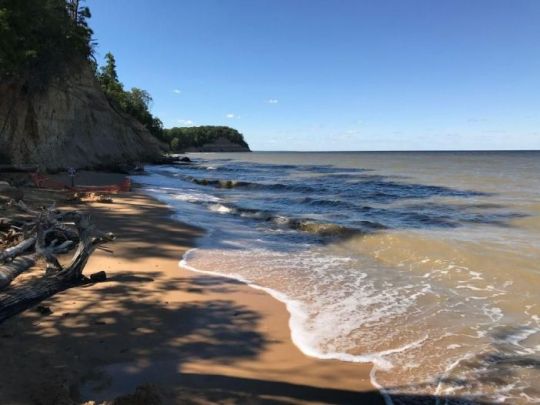
Calvert Cliffs State Park
(Daniel Slim/AFP via Getty Images)
Perhaps the most well-known fossil site on the east coast, the Calvert Cliffs cover about 24 miles of shoreline in Maryland. More than 600 species of fossils, including prehistoric oyster shells, mollusks and scallops as well as shark teeth, have been found on the shores. You might even find a megalodon tooth—most likely, however, you’ll find smaller teeth of other kinds of ancient sharks. Most finds date back to the Miocene era, or around 15 million years ago.
You might be wondering why it is so easy to find shark teeth millions of years old on the beach. According to Smithsonian marine paleobiologist David Bohaska, sharks lose their teeth and regrow new ones constantly. In its lifetime, he explains, a single shark can have thousands and thousands of teeth.
One location where you can access the cliffs is at Calvert Cliffs State Park in Lusby, Maryland. Just a 1.8-mile walk from the parking lot, you can scour the open beach area with a small shovel and sieve—these you’ll need to bring yourself—for remnants of prehistoric sea life. (Don’t bring a hammer or bang on rocks as this will only damage the fossil, Bohaska advises.) The cliffs are layered at a slant, so you’ll find fossils from different geologic time periods depending on where you are.
“The layers at the top are the more recent chapters and the stuff at the bottom is older,” Bohaska explains. He warns that it is illegal to climb on the cliffs or search beneath them in this area, so pay attention to signage.
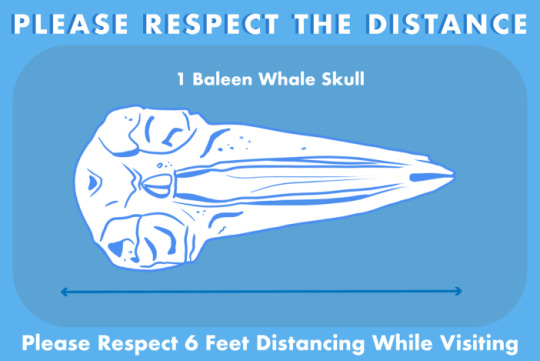
Don’t forget to stay socially distant while fossil collecting during the Covid-19 pandemic. Try to give others about six feet of room—about the size of a baleen whale skull, for reference.
(Courtesy of Stratford Hall)
“You’re out in the wild, be aware,” says Bohaska. “If you look at the cliff and it has a crack, or if there’s a tree overhanging, that’s not a place you want to stand.”
You can find lots of in-depth information about where to look for fossils and how to determine what you found on the Maryland Geological Survey website. You can also download Smithsonian Scholarly Press’ The Geology and Vertebrate Paleontology of Calvert Cliffs, Maryland, USA online.
Be sure to plan ahead for filled-to-capacity closures on busy holiday weekends like Labor Day. And pack your mask: The Maryland Park Service requires face coverings in public buildings and outdoor public spaces wherever social distancing is not possible.
Stratford Hall – Stratford, Virginia
youtube
In 1717, Virginia colonist and politician Thomas Lee purchased Stratford Hall, a 1,200-acre property in Stratford, Virginia. About 17 million years earlier, during the Miocene era, however, the Stratford Hall estate’s towering 150-foot-high cliffs were actually part of the seafloor, according to its website.
In 2013, amateur paleontologist Jon Bachman—who serves as Stratford Hall’s educational events coordinator—found a 15-million-year-old whale skull on the shores of the Potomac River at the four-generation Lee family home, where Robert E. Lee was born in 1807. The six-foot-long, 1,000-pound fossil was unearthed when the banks of the river eroded that summer. The skull was “the biggest” found near the cliffs, but there’s plenty more where that came from, including “shark-toothed porpoises, salt-water crocodiles, sea cows, gopher turtles [and]rays,” according to Stratford Hall’s website.
The cliffs still turn loose small fossils as they erode. As sediment accumulated for millions of years, the ocean underwent a series of marine transgressions, meaning that over a long period of time, the shoreline receded and advanced several times. Each time that movement happened a new layer of sediment was dumped, and those layers can be seen as one looks up at the cliffs.
“The back and forth of the ocean created the right environment to preserve the remains of countless animals,” Bachman explains. “Now, as the river current scours the cliffs, these fossils are exposed and slowly emerge out of the cliffs. That’s what people want to find.”
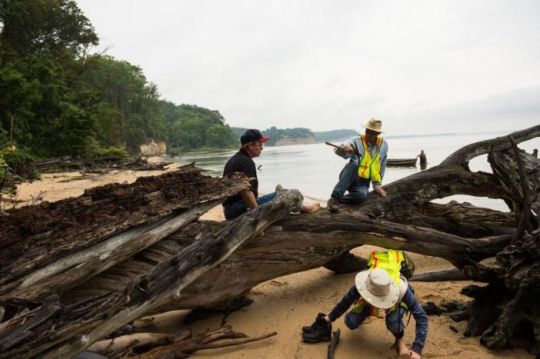
Jon Bachman (left) and Howard University anatomy professor Daryl Domning and his daughter, Charlotte Domning, make their way to the site to excavate the skeleton of a prehistoric whale in August 2013.
(Nikki Kahn/The Washington Post via Getty Images)
Today, the waterline at the Stratford cliffs is about 16 million years old, Bachman says.
Due to irresponsible fossil hunting practices, however, visitors must purchase a grounds pass ($8 for adults and $5 for kids) to access a small, well-marked, 100-yard-long collecting area on the beach. The Hall still offers guided collecting tours led by one of their Paleo Patrol volunteers, explains Alex Withers, an events coordinator at Stratford Hall. Tours are typically about four hours long. Withers notes there is limited weekend tour availability left in the 2020 season, but they are taking reservations for 2021. (You can read up about their COVID-19 guidelines on their website.)
Bachman, who used to be a fourth grade teacher in Virginia’s Prince William County, says making fossil collecting a lifelong hobby is a worthwhile adventure. “It takes patience, this stuff isn’t littering the ground,” he says. “It’s humbling and fascinating hobby.”
Start with reviewing the principles of geology, Bachman suggests. Then move on to studying the geology in your area, which will tell you what rock formation and landscape features are nearby—and therefore, what fossils might be found there. State geologic societies have useful information on their websites.
“It’s just a delight and you don’t have to get a degree in it to enjoy it,” he adds. “You can educate yourself in stages. It’s about familiarizing yourself with the landscape around us.”
Westmoreland State Park Fossil Beach – Montross, Virginia

Westmoreland State Park Fossil Beach
(Virginia State Parks)
About 70 miles south of the Natural History Museum, Westmoreland State Park’s Fossil Beach is another hotbed for prehistoric shark teeth, but what’s really eye-catching about the location is the stratigraphy—or rocky layers—of the cliffs. Gazing up at the cliffs’ stripes is like looking 25 million years back in time; each layer represents millions of years of geologic history. Fossil Beach neighbors Stratford Hall, so the geology in both areas is similar.
“The river current erodes the sediment and fossilized material washes up on the beach,” explains Bachman, who lives nearby and collects fossils at this location. Bachman’s wife, Dianne, recently found the lower part of a leg bone, which they later found out may belong to a Miocene pseudo-toothed pelican, Pelagornis miocaenus, after having their colleague Robert Weems, a paleontologist with the U.S. Geological Survey, take a look. The bone is about six inches long and hollow, much like bird bones are today.
“People probably stepped over it a million times,” says Bachman.
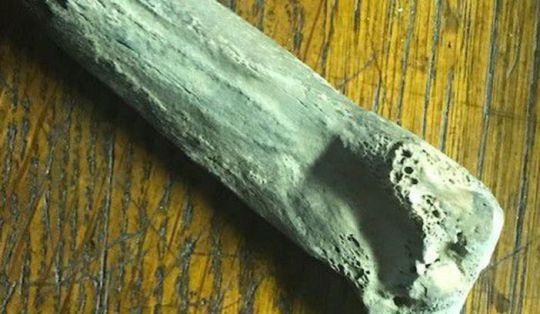
Jon Bachman, an amateur paleontologist and avid fossil collecter, says his favorite find isn’t his own. His wife found a Miocene era bird bone recently.
(Courtesy of Jon Bachman)
The area was once home to the unique prehistoric whale species, Eobalaenoptera harrisoni. A model of the 14 million-year-old baleen whale hangs in the Caroline County visitor’s center just a short drive from Fossil Beach. When the original fossil was excavated in the 1990s, researchers recovered half of the full skeleton, making it one of the most complete and largest prehistoric whale skeletons in the U.S. The skeleton is housed in the Virginia Museum of Natural History in Martinsville.
During the pandemic, “face coverings are required in all park facilities and where social distancing is not possible,” according to the park’s website. Virginia State Parks also recommends bringing your own soap and hand sanitizer. Of course, respect social distancing and keep a six-foot space between yourself and others. Step aside to let others pass on trails.
Purse State Park – Nanjemoy, Maryland
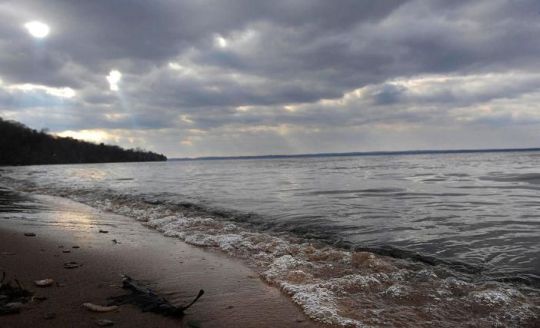
Purse State Park
(Kim Hairston/Baltimore Sun/Tribune News Service via Getty Images)
Just over an hour’s drive south of D.C., Purse State Park is located on a stretch of the banks of the Potomac River called Wades Bay. Paleontologist Michelle Pinsdorf of Smithsonian’s National Museum of Natural History says most of the fossils you’ll find at this site are from the late Paleocene—specifically the Aquia Formation rock layer, which is 55 to 59 million years old.
“During this time period, many types of animals were evolving and diversifying to adapt to the extinction event at the end of the Cretaceous time period,” Pinsdorf writes in an email to Smithsonian magazine. “Because the deposit is marine in origin, the teeth of a wide variety of shark and bony fish species can be found in this formation.”
Alongside shark teeth, you may find an occasional prehistoric crocodile tooth, which by comparison sort of look like “an ice cream cone with an almost silky texture,” says Bohaska.
You’ll also spot plenty of fossilized shells. Pinsdorf says prehistoric oyster shells are among her favorite finds at Purse State Park. “Although they are heavily eroded and don’t have much of the shell pattern or shape left, they are a beautiful purple color and have an interesting luster and smooth texture,” she says.
The ideal time to search is during low tide when there is enough shoreline to scour. “But if you go in the days after a storm or rough waters, you’re more likely to find fossils that have recently eroded out of the bedrock, and are in better condition as a result,” explains Pinsdorf.
The trails are unmarked so it’s important to carry a compass and map, according to Maryland’s tourism department. Pinsdorf suggests taking a quarter-mile trail westward, across the road from the Park’s parking area on Route 224 (Riverside Road), to a narrow stretch of beach along Wade’s Bay.
“Bringing a colander or mesh screen is recommended to aid in sifting the gravel, in which small but numerous shark teeth and can be found,” she says. “Larger, weathered oyster shell fragments are present at this site also.”
During the coronavirus pandemic, face coverings are required in park buildings and outdoor areas where social distancing is not possible. Some parks have introduced additional cleaning procedures for restrooms or closed public restrooms. Others may be offering portable bathrooms instead, according to Maryland’s Department of Natural Resources.
Dinosaur Park – Laurel, Maryland
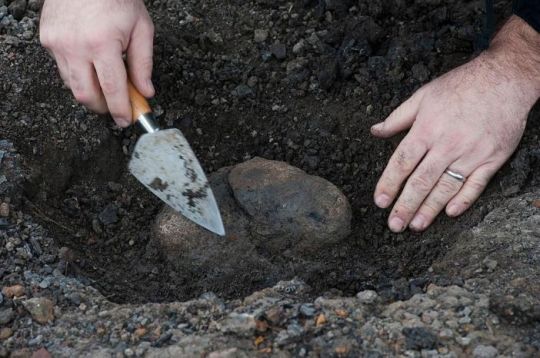
Steve Jabo, a fossil preparator at the Smithsonian, works on a large fossilized dinosaur bone found at Dinosaur State Park in 2011.
(Marvin Joseph/The Washington Post via Getty Images)
Originally a prime site for iron mining, African American miners in 1858 were the first to discover dinosaur fossils at this site. Geologist Philip Thomas Tyson brought the fossilized bones from the mines to a scientific conference in 1859, where they were officially identified as dinosaur remains.
“It’s a place where people have been working for a few hundred years,” explains paleontologist Matt Carrano of Smithsonian’s National Museum of Natural History. If the area where Dinosaur Park now stands hadn’t been mined at all, it would look like a normal Maryland hillside covered in vegetation. “It’s only a good spot for fossil collecting because it was mined for so long,” he says.” You’re looking at bedrock where there should be soil.”
Today, Dinosaur Park features fossilized dino bones, including some from Maryland’s state dinosaur Astrodon johnstoni, and floral remnants from the early Cretaceous period about 115 million years ago. At the time, the region would have resembled something like a swampy bayou with muddy streams. According to Carrano, the sediment was a very fine, almost “pottery-quality,” clay-like material.
“You’re walking on a clay layer that was deposited 110 million years ago,” Carrano says. Now, when it rains, the clay absorbs the water and then dries out again, revealing fossil fragments in that process. The most common finds are plant material, like wood and pine cones.
“Every now and then the conditions are just right and you get a situation when the environment is saving things instead of recycling them,” Carrano explains.
youtube
Due to COVID-19, all public programs and fossil collecting at Dinosaur Park are currently on hold, but the park area is open from sunrise to sunset. The unrestricted area features a Cretaceous-era garden and a climbable dinosaur “skeleton.” Signs describe the kinds of dinosaurs that once roamed the area, what Maryland’s prehistoric environment looked like and the African American history in the area, according to the park’s website.
Dinosaur Park usually serves as an outdoor laboratory, where the public can work alongside paleontologists to help uncover the past on the first and third Saturdays of the month or by appointment. Hundreds of fossils discovered by visitors have been collected and cataloged to date, enhancing our knowledge about the ancient ecosystem that once existed here.
“There’s a steady stream of new discoveries,” Carrano says. “We’re in this phase when the variety is much greater than we knew, just because we didn’t have much collected from the area. Many times, you’ll know you have something new, but you don’t have enough of it to give it a new name.”
!function(f,b,e,v,n,t,s) {if(f.fbq)return;n=f.fbq=function(){n.callMethod? n.callMethod.apply(n,arguments):n.queue.push(arguments)}; if(!f._fbq)f._fbq=n;n.push=n;n.loaded=!0;n.version='2.0'; n.queue=[];t=b.createElement(e);t.async=!0; t.src=v;s=b.getElementsByTagName(e)[0]; s.parentNode.insertBefore(t,s)}(window, document,'script', 'https://connect.facebook.net/en_US/fbevents.js'); fbq('init', '452270575524133'); // smithsonianchannel fbq('init', '784323455034815'); // circulation fbq('init', '538226103776412'); // smithsonian.com fbq('track', 'PageView'); window.fbAsyncInit = function () { FB.init({ appId: '241090599274511', autoLogAppEvents: true, xfbml: true, version: 'v2.9' }); FB.AppEvents.logPageView(); };
(function (d, s, id) { var js, fjs = d.getElementsByTagName(s)[0]; if (d.getElementById(id)) { return; } js = d.createElement(s); js.id = id; js.src = "https://connect.facebook.net/en_US/sdk.js"; fjs.parentNode.insertBefore(js, fjs); }(document, 'script', 'facebook-jssdk')); Source Link
source https://highvoltagearea.com/five-places-where-you-can-collect-fossils-around-d-c/?utm_source=rss&utm_medium=rss&utm_campaign=five-places-where-you-can-collect-fossils-around-d-c
0 notes
Photo

Striatolamia macrota Shark Tooth Fossil - Paleocene, USA | Genuine + COA
Authentic Striatolamia macrota Fossil Shark Tooth – Late Paleocene, Aquia Formation
This is a genuine Striatolamia macrota fossil shark tooth, carefully sourced from the Late Paleocene (Thanetian) deposits of the Aquia Formation, Piscataway Member, at Wades Bay, Charles County, Maryland, USA. Dating back approximately 59–56 million years, this well-preserved tooth comes from an extinct species of sand tiger shark that thrived in prehistoric marine environments.
Striatolamia macrota belonged to the family Odontaspididae and was an early relative of modern sand tiger sharks. Known for their elongated, narrow teeth with sharp cusps, these sharks were likely opportunistic predators that fed on fish and other marine life.
Geology & Formation:
The Aquia Formation is a significant Paleocene-aged marine deposit found in the mid-Atlantic United States. The Piscataway Member is particularly rich in well-preserved vertebrate fossils, including numerous species of sharks, rays, and bony fish. This formation provides valuable insight into marine ecosystems following the mass extinction that ended the Cretaceous period.
Fossil Information:
Scientific Name: Striatolamia macrota
Location: Wades Bay, Charles County, Maryland, USA
Formation: Aquia Formation (Piscataway Member)
Geological Age: Late Paleocene (Thanetian) (~59–56 million years ago)
Fossil Type: Shark Tooth
Guaranteed Authenticity:
All of our fossils are 100% genuine and come with a Certificate of Authenticity. The specimen shown in the images is the exact fossil you will receive.
Size & Presentation:
Scale Rule / Cube = 1cm (see photos for accurate sizing)
Specimen dimensions provided in listing images
Natural preservation with excellent details
Perfect for:
✔ Fossil Enthusiasts & Collectors
✔ Shark Tooth Collectors
✔ Educational Use & Teaching
✔ Unique Gifts for Paleontology Lovers
✔ Museum & Display Collections
✔ Natural History Exploration
Own a rare and beautifully preserved fossil from an extinct species of sand tiger shark and a piece of prehistoric marine history today! Fast & Secure Shipping Available.
#Striatolamia macrota#fossil shark tooth#Paleocene fossil#Thanetian fossil#Aquia Formation#Piscataway Member#Maryland fossil#USA fossils#prehistoric shark#fossilized tooth#natural history#paleontology#collectible fossil#rare fossil specimen#shark tooth collector#museum quality fossil#ancient marine predator
0 notes